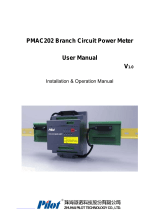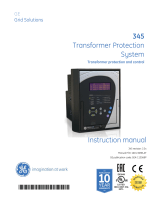18. Station communication
The relay supports a range of communication protocols
including IEC 61850 Edition 2, IEC 61850-9-2 LE, IEC
60870-5-103, Modbus
®
and DNP3. Profibus DPV1
communication protocol is supported with using the protocol
converter SPA-ZC 302. Operational information and controls
are available through these protocols. However, some
communication functionality, for example, horizontal
communication between the relays, is only enabled by the IEC
61850 communication protocol.
The IEC 61850 protocol is a core part of the relay as the
protection and control application is fully based on standard
modelling. The relay supports Edition 2 and Edition 1 versions
of the standard. With Edition 2 support, the relay has the latest
functionality modelling for substation applications and the best
interoperability for modern substations. It incorporates also the
full support of standard device mode functionality supporting
different test applications. Control applications can utilize the
new safe and advanced station control authority feature.
The IEC 61850 communication implementation supports
monitoring and control functions. Additionally, parameter
settings, disturbance recordings and fault records can be
accessed using the IEC 61850 protocol. Disturbance
recordings are available to any Ethernet-based application in
the standard COMTRADE file format. The relay supports
simultaneous event reporting to five different clients on the
station bus. The relay can exchange data with other devices
using the IEC 61850 protocol.
The relay can send binary and analog signals to other devices
using the IEC 61850-8-1 GOOSE (Generic Object Oriented
Substation Event) profile. Binary GOOSE messaging can, for
example, be employed for protection and interlocking-based
protection schemes. The relay meets the GOOSE performance
requirements for tripping applications in distribution
substations, as defined by the IEC 61850 standard (<10 ms
data exchange between the devices). The relay also supports
the sending and receiving of analog values using GOOSE
messaging. Analog GOOSE messaging enables easy transfer of
analog measurement values over the station bus, thus
facilitating for example the sending of measurement values
between the relays when controlling parallel running
transformers. In REU615, analog GOOSE messaging is
employed in control schemes of parallel running transformers
where measured values are exchanged between the relays.
The relay also supports IEC 61850 process bus by sending
sampled values of analog currents and voltages and by
receiving sampled values of voltages. With this functionality the
galvanic interpanel wiring can be replaced with Ethernet
communication. The measured values are transferred as
sampled values using IEC 61850-9-2 LE protocol. The intended
application for sampled values shares the voltages to other 615
series relays, having voltage based functions and 9-2 support.
615 relays with process bus based applications use IEEE 1588
for high accuracy time synchronization.
For redundant Ethernet communication, the relay offers either
two optical or two galvanic Ethernet network interfaces. A third
port with galvanic Ethernet network interface is also available.
The third Ethernet interface provides connectivity for any other
Ethernet device to an IEC 61850 station bus inside a switchgear
bay, for example connection of a Remote I/O. Ethernet network
redundancy can be achieved using the high-availability
seamless redundancy (HSR) protocol or the parallel
redundancy protocol (PRP) or a with self-healing ring using
RSTP in managed switches. Ethernet redundancy can be
applied to Ethernet-based IEC 61850, Modbus and DNP3
protocols.
The IEC 61850 standard specifies network redundancy which
improves the system availability for the substation
communication. The network redundancy is based on two
complementary protocols defined in the IEC 62439-3 standard:
PRP and HSR protocols. Both the protocols are able to
overcome a failure of a link or switch with a zero switch-over
time. In both the protocols, each network node has two
identical Ethernet ports dedicated for one network connection.
The protocols rely on the duplication of all transmitted
information and provide a zero switch-over time if the links or
switches fail, thus fulfilling all the stringent real-time
requirements of substation automation.
In PRP, each network node is attached to two independent
networks operated in parallel. The networks are completely
separated to ensure failure independence and can have
different topologies. The networks operate in parallel, thus
providing zero-time recovery and continuous checking of
redundancy to avoid failures.























